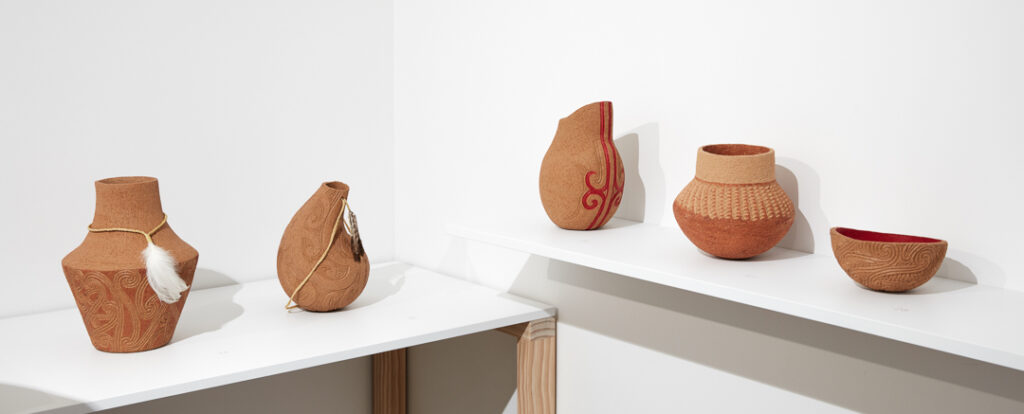
Stevei Houkāmau, Ngaro nga tikanga tuku iho/Lost traditions of my ancestors, (detail), 2023. Photograph by Samuel Hartnett, courtesy of Objectspace.
Zoe Black tracks the journey of Stevei Houkāmau in finding whakapapa connections through ceramics.
There is an inherent slow reveal in the recent work of Stevei Houkāmau (Ngāti Porou, Te Whānau-ā-Apanui, Rangitāne). Her lengths of uku kākano (clay seeds) have a commanding physical presence, but it is necessary to also view at an intimate distance to understand the delicate details etched on the surface of each component and the stories these patterns convey.
This macro/micro reveal relates to the foundation of Stevei’s work: the relationship and exploration of whakapapa. The connection individuals have to whakapapa is seen in the singular notches and lines inscribed on each kākano or seed, spiralling out to full chain lengths, representative of generations of tūpuna, stretching back to atua and beyond.
Stevei’s practice is one where the surface of uku is crafted to honour the texture and beauty of the material. Her forms are a collaboration between the clay and the artist, a reciprocal exchange where the works bring balance to each other, shaped by the wā (time and space) that surrounds them.
Stevei Houkāmau has been pushing the forms of uku practice since she first approached clay in 2011. After closing a prior career as a professional sportsperson, Stevei was first drawn to the beauty and challenge of tā moko and approached her study at Toihoukura (School of Māori Art and Design) with the intention of becoming a tā moko artist. However, during a wānanga at Toihoukura she witnessed Manos Nathan carving into uku and realised the synergy between marking clay and the traditions of tā moko. Seeing the fluidity that was possible in this technique redefined her practice and she intuitively began carving uku as her primary method of making with support from kaiako Dave Cameron. Stevei saw the connection to Papatūānuku and the way in which earth cracked as representative of scribing skin, how the texture and sympathy of clay was a perfect conduit to convey the vital relationship between tangata and whenua. Uku became the preferred vehicle to explore her whakapapa and define her artistic language.
“From the first moment I made an ipu and carved it I was hooked, it was like a whole world opened up and I literally did a 180 degree change in direction. It’s now part of my life, it’s not just an art form but part of my spirit and keeps me grounded.
“For me clay is an alternative to skin, I approach clay as if it is skin, I see a vessel and imagine how I can adorn and mark it to not only tell the story but to also enhance it, just like a tattooist approaches the body.”
It has been widely noted that fired clay does not have the legacy within toi Māori of other creative practices such as whakairo or raranga. However connections through our traditional whakaaro to the origins of clay, through creation stories and atua wahine such as Hineahuone and Hineukurangi, have provided artists with mātauranga to explore the creative potential within uku. Stevei expresses the inherent relationship Māori have with the whenua as a cursor for the ease with which she is able to work with uku. “Our hands remember the clay. It is healing, it’s the ultimate material for us to feel a connection with this land.”
Collective Ngā Kaihanga Uku was formative in the beginning stages of Stevei’s career and she acknowledges Wi Taepa as a tuakana in her practice, teaching her how to sustain creative momentum and shape her confidence in pushing the possibilities of clay. Her focus during these foundational years was vessels, hand-built with a carved exterior surface and bold red pigment embellishments. Sustained time was spent perfecting her hand-building techniques and understanding how she could maintain structural integrity with forms that echoed natural shapes in te tai ao (the natural world) while experimenting with surface precision cuts continually in reference to whakapapa.
As part of the 2016 group exhibition, Whenua Hou – New Māori Ceramics, Stevei created three vessels representative of her practice at the time. She incorporated patterns indicative of toi Māori and designs found across Te Moana-nui-a-Kiwa, acknowledging visual connections and the shared kinship between tangata whenua and Pacific peoples.
“The three spheres Marama, Mun and Pulan represent the three moons of Oceania, watching over the group. Line, colour, and the form of the vessel are utilised to tell Houkāmau’s story of this collective group — interconnected and reliant on each other for support and nourishment. They become an extension of a lifeline to whenua (land) and the interconnectedness of all things.”
Progressing from vessel forms, the development of the uku kākano began while staying at an artist residency in New Mexico in 2021 where Stevei worked with Santa Clara Pueblo Native American artists Roxanne Swinzel and Rose Bean Simpson. Seeing centuries-old seeds stored in Roxanne and Rose Bean’s heirloom seed bank had a lasting impression. In holding the heirloom seeds, she described holding a literal expression of whakapapa in every sense of the word.
“I was lucky enough to have been allowed to hold blue corn seeds, the whakapapa went so far back it was hard for Roxanne to pinpoint the date. I felt like I was holding a part of Roxanne and Rose Bean’s whakapapa—their past, present and what will be their future.”
Since then, Stevei has considered the uku kākano as a repeated form to continue to push her technical skills and experimentation of scale, all the while expressing her understanding of whakapapa.
Each work in her uku kākano series combines hand-built seed or bead shapes that differ in size, reflective of individuals, tūpuna and atua within the genealogy line. The carved surfaces relate to taonga in te ao Māori that incorporate incisions or notches as a physical prompt in reciting karakia or whakapapa—tokotoko (orator’s staff) and tokotauwaka—alongside rosary or prayer beads. When strung together, the uku kākano become physical manifestations of encoded knowledge connecting us to past and future.
- Stevei Houkāmau, Kia Whakatōmuri te haere whakamua, (detail), 2023. Uku, paint, feathers, sealer, powder coated wire. Photograph by Jess O’Brien, courtesy of The New Zealand Portrait Gallery Te Pūkenga Whakaata.
- Stevei Houkāmau, Kia Whakatōmuri te haere whakamua, 2023. Uku, paint, feathers, sealer, powder coated wire. Photograph by Jess O’Brien, courtesy of The New Zealand Portrait Gallery Te Pūkenga Whakaata.
Winning the 2023 Kiingi Tuheitia Portraiture Award with Kia Whakatōmuri te haere whakamua, a strand of uku kākano draped across the wall, celebrated the power of Stevei’s conceptual understanding of whakapapa in this form.
“Kia Whakatōmuri te haere whakamua is about my great great grandmother Hinemaurea. She is the daughter of Raramaitai and was married to Te Aotaki. They occupied Wharekahika in the 16th century and had five children. She was mother of Ruataupare, who Tuwhakairiora (the great Ngati Porou chief) married to ensure the security of Ngai Tuiti whenua, which infused the stock of Porourangi throughout Tairāwhiti. Hinemaurea was seen to have great mana and has two existing marae named after her, including our marae in Wharekahika, East Coast.”
This work, as a direct representation of Stevei’s tūpuna and whakapapa, was praised by the award’s judges as masterful in its execution, exquisitely representing the proverb ‘kia whakatōmuri te haere whakamua’ – walking backwards into our future while keeping our eyes fixed on our past.
- Stevei Houkāmau, Ngaro nga tikanga tuku iho/Lost traditions of my ancestors, 2023. Black uku, white uku, sealer, wire, feathers, acrylic paint, pāua, pounamu.Photograph by Samuel Hartnett, courtesy of Objectspace.
- Stevei Houkāmau, Ngaro nga tikanga tuku iho/Lost traditions of my ancestors, (detail), 2023. Photograph by Samuel Hartnett, courtesy of Objectspace.
- Stevei Houkāmau, Wahine Toa, (detail), 2023. Black uku, jade, paint, sealer and fishing wire. Photograph by Samuel Hartnett, courtesy of Objectspace.
Her latest work, Ngaro nga tikanga tuku iho / Lost traditions of my ancestors, looks at traditions of hei (lei, neck garlands) to extend whakapapa as uku kākano.
Ambitious in scale, the installation consists of five strands, the longest over four metres. The strand forms are evocative of hei / lei, the adornment ubiquitous in the Pacific but not widely seen now in te ao Māori. Traditionally, hei were made from feathers, plant fibres, seeds or flowers and may adorn poupou, showing the mana of the carved figure. Now, within Aotearoa, Pacific lei are more easily found, often draped around photographs of whānau members passed, as a way to show aroha and connection.
Within this work, Stevei acknowledges whakapapa across Te Moana-nui-a-Kiwa and ancestral lines back to Hawaiki through patterns drawn from Aotearoa and further through the Pacific. Stevei’s uku kākano as hei recognise the disconnections to whenua of both Māori and Pacific whānau through displacement and migration, and the reinterpretation of traditions that happen when these disconnections occur. The strands are installed at scale to adorn the space as a lament for traditions lost and to create a visual portal, pulling and twisting on the notions of time and space that run through Stevei’s practice.
Reimagining lost traditions and reclaiming mātauranga Māori will continue to be a provocation for Stevei in future projects. Stevei sees the potential in this focus to reflect the urgent motivation to reshape narratives and ideas within contemporary Māori experience and ultimately a formidable outcome for her creative practice.
“We are not just people who are struggling, there is richness and celebration in our culture, a beauty that I want to keep drawing attention to. Each seed is an extension of a person and it tells a story. It tells a history of a people. It tells of a present version of us as a people and a society. It holds the hopes and dreams of who we wish to become and who we must become to ensure the future of our people and of our whakapapa.”
About Stevei Houkāmau
Stevie Houkāmau is a full-time uku artist who lives and works within the Te Whanganui-a-Tara Wellington Region. Stevei Houkāmau has worked with clay since 2011, preferencing uku because of its ability to convey our links to the geological and spiritual past—uniting tangata, tūpuna, and whenua, while speaking to the critical connection tangata whenua have to place and earth. Stevie has exhibited and has works in collections both nationally and internationally. Stevie has represented Aotearoa at FESTPAC, Guahan and Indigenous Art Gatherings and completed residencies in the US, Australia and in Aotearoa. Recently she has exhibited at Pataka Art + Museum, Porirua; The Suter Art Gallery, Whakatū Nelson and Objectspace, Tāmaki Makaurau Auckland. Follow @ukumad
About Zoe Black
 Zoe Black (Ngāpuhi, Ngāti Hine, Pākehā) is the deputy director of Objectspace in Tāmaki Makaurau Auckland, Aotearoa New Zealand. She has been working in galleries for the past ten years. Her curatorial practice has focused on community development and advocating for critically under-represented craft and object art forms. Follow @zoe.a.black
Zoe Black (Ngāpuhi, Ngāti Hine, Pākehā) is the deputy director of Objectspace in Tāmaki Makaurau Auckland, Aotearoa New Zealand. She has been working in galleries for the past ten years. Her curatorial practice has focused on community development and advocating for critically under-represented craft and object art forms. Follow @zoe.a.black







